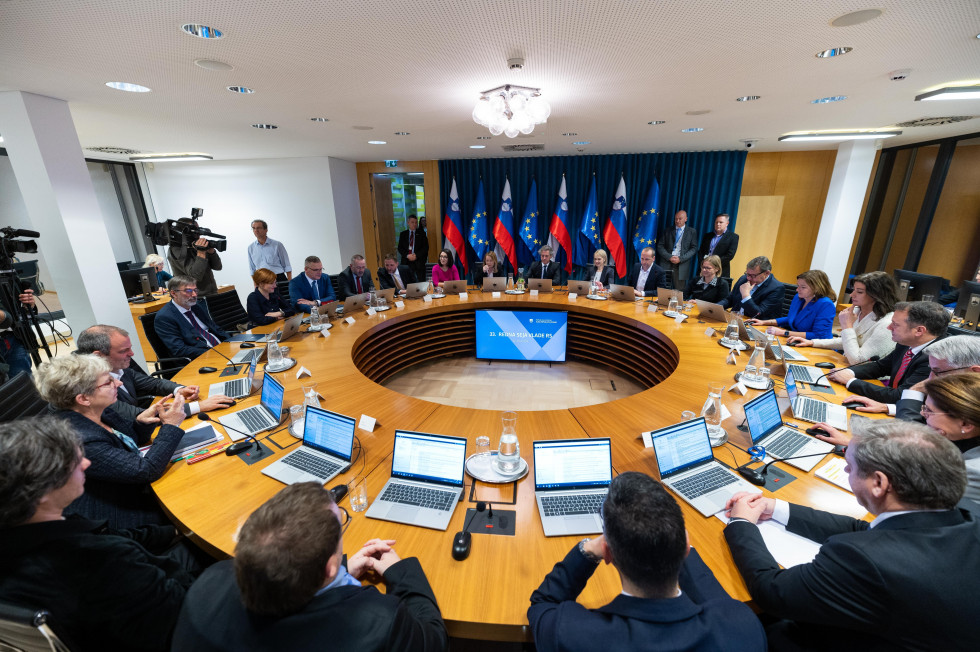44th regular meeting of the Government of the Republic of Slovenia
The Government adopted the Ordinance on the framework for the preparation of the general government budgets for the 2024–2026 period. The framework for the preparation of state sector budgets for the 2024–2026 period envisages a deficit of 2.8 % of gross domestic product (GDP) in 2024, 2.2 % of GDP in 2025 and 1.3 % of GDP in 2026. The deficit of the state budget is projected at 2.3 % of GDP for 2024, 1.6 % of GDP for 2025 and 1.2% of GDP for 2026. The framework envisages a balanced budget for local community units (municipalities) in 2024 and a surplus of 0.1 percent of GDP in 2025–2026. It sets an expenditure ceiling for the pension and health insurance funds. Upon termination of the general escape clause at the EU level, the Government expects a fiscal deficit below the reference value of 3% of GDP in 2024 and a further gradual reduction of the deficit in subsequent years. A gradual reduction of government debt towards the reference value of 60% of GDP is also envisaged during this period. In the medium term, government debt is expected to decrease to 63.5% of GDP and the general government balance to -1.3 % of GDP. In 2024, public financial consolidation will again be in the spotlight and will have to be implemented gradually, as this is the only way to ensure the maintenance of economic growth and a sufficient volume of investment. In this regard, the Government has followed the European Commission’s guidelines on the reference value of government deficit, public debt trends, maintaining a high share of national investment and ensuring efficient use of EU funds when national current expenditure growth lags behind the medium-term potential GDP growth. The framework has been prepared on the basis of the Spring Forecast of Macroeconomic Trends of the Office for Macroeconomic Analysis and Development and taking into account Statistical Office data regarding the primary general government aggregates for 2022, with uncertainty regarding the macro medium-term period remaining high.
The Government also adopted the proposal for amendment to the State Border Control Act, thus establishing a legal basis for payment of compensation to landowners, including in the event that temporary technical obstacles are removed before easement has been established. In the course of the procedures for establishing an easement for the public benefit, there are situations where temporary technical obstacles are completely removed from the land before the easement is established or there is no longer a need for the easement. According to the State Border Control Act (the ZNDM-2) in force, the first condition for the payment of compensation is the entry of the easement in the land register. Where the temporary technical barriers are completely removed before the contract is concluded or the decision is issued, no easement for the public benefit shall be established. However, landowners are still entitled to compensation for the period from the expiry of 24 months from the date of erection to the date of removal of the temporary technical barriers. The proposed act therefore establishes a legal basis for the payment of such compensation.
The Government also approved the Resolution on the National Programme in the Field of Illicit Drugs for the 2023–2030 period. The main objectives of the National Programme in the Field of Illicit Drugs 2023–2030 are to strengthen prevention and early intervention in order to reduce the number of new drug users among the younger generation and the number of crimes involving narcotic drugs. Support will also be provided for the development of programmes to help prevent the increase of or reduce HIV and hepatitis B and C infections and overdose deaths and for the development of treatment and psychosocial programmes for drug users, with a focus on upgrading and expanding treatment programmes and programmes that contribute to reducing the social exclusion of drug users. As before, specific programmes for vulnerable groups will be developed and programmes for drug users in prisons will be upgraded. Key objectives include ensuring the participation of different actors, in particular civil society, in all areas of coordination and decision-making, strengthening international cooperation to ensure international standards are followed, and ensuring the linking and integration of the databases of state institutions and public institutions (health, social, criminological data, etc.) and the upgrading of the information system in the field of collection, compilation, processing and dissemination of data in the field of drugs and of the system of early detection of new drugs and of notification. Last but not least, another of the objectives is to strengthen activities aimed at combating organised crime, illicit drug trafficking, money laundering and other forms of drug-related crime.


